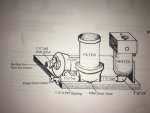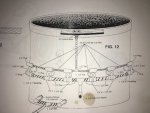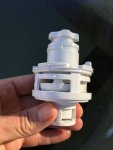I'm super embarrassed to even ask for help on this because I'm sure we made some extremely stupid mistakes when putting together our cedar hot tub kit. The manufacturer left a lot to be desired in their instructions and now there is a problem with the operation of the jets. I'll try to explain...
It's a ~465-gallon tub with 5 "regular size" jets and 1 "turbojet." The turbojet works well--it has its own air intake opening that I can hear sucking air. The other 5 jets have never worked well and I can't hear air being sucked into the other air intake that's attached to all 5 of them. When I emptied the tub and refilled it just below the jet level, I turned the pump on high and the 5 jets blasted harder than they ever had before. I could also hear the air going into the air intake. But once the water level was full they went back to weak and not sucking air.
Of the regular-sized jets, we have 2 sets of stacked jets and 1 by itself. I'm pretty sure it's our stupid plumbing that is messing things up but I need to understand how to do it right before we start cutting things.
Here are the hilarious photos of the plumbing done by two people who are smart in other areas of life, I swear.
The small hose is supposed to be for air and the thick hose is for water.
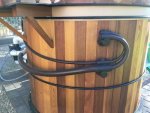
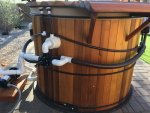
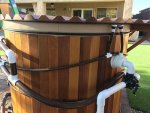
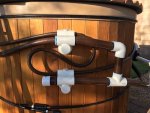
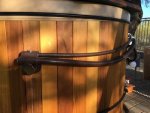
My main question is about jets that are on different levels, i.e. one above the other. Do they each have to have their own air intake tube or can they share off one main air line? Here's a diagram I found from another manufacturer that shows a similar setup to ours but they have each row of jets with its own air intake.

Does this make sense to anyone? I've searched and searched the internet to try to figure it out and I'm still stumped... Don't laugh! OK, you can laugh a little because I definitely am.


Thanks for any help you guys can give us!!!
It's a ~465-gallon tub with 5 "regular size" jets and 1 "turbojet." The turbojet works well--it has its own air intake opening that I can hear sucking air. The other 5 jets have never worked well and I can't hear air being sucked into the other air intake that's attached to all 5 of them. When I emptied the tub and refilled it just below the jet level, I turned the pump on high and the 5 jets blasted harder than they ever had before. I could also hear the air going into the air intake. But once the water level was full they went back to weak and not sucking air.
Of the regular-sized jets, we have 2 sets of stacked jets and 1 by itself. I'm pretty sure it's our stupid plumbing that is messing things up but I need to understand how to do it right before we start cutting things.
Here are the hilarious photos of the plumbing done by two people who are smart in other areas of life, I swear.
The small hose is supposed to be for air and the thick hose is for water.





My main question is about jets that are on different levels, i.e. one above the other. Do they each have to have their own air intake tube or can they share off one main air line? Here's a diagram I found from another manufacturer that shows a similar setup to ours but they have each row of jets with its own air intake.

Does this make sense to anyone? I've searched and searched the internet to try to figure it out and I'm still stumped... Don't laugh! OK, you can laugh a little because I definitely am.
Thanks for any help you guys can give us!!!


